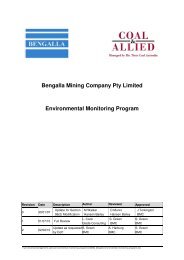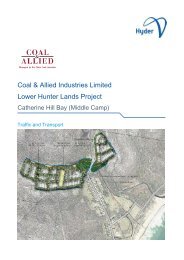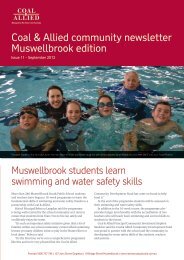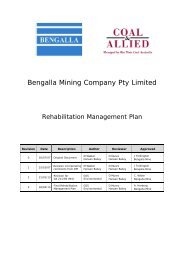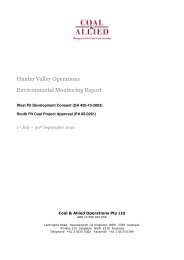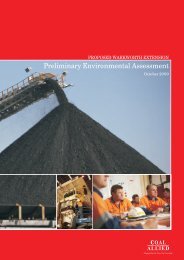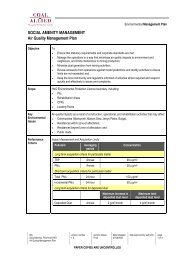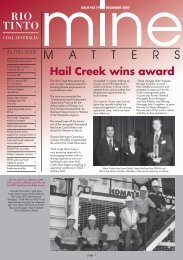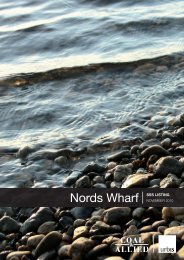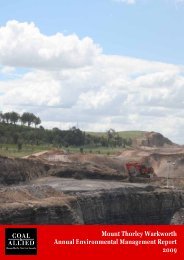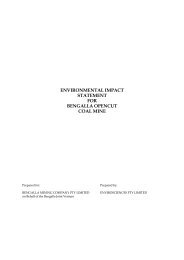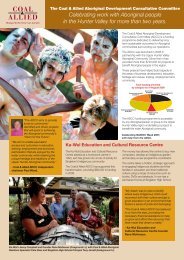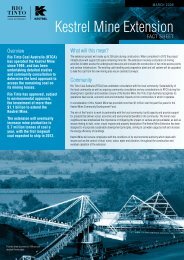HVO 2009 Annual Environmental Management Report - Final
HVO 2009 Annual Environmental Management Report - Final
HVO 2009 Annual Environmental Management Report - Final
Create successful ePaper yourself
Turn your PDF publications into a flip-book with our unique Google optimized e-Paper software.
Coal & Allied – Hunter Valley Operations<br />
Rehabilitation Trials and Research<br />
<strong>HVO</strong> – Timber Monitoring<br />
Local independent environment consultants ENSR Australia Pty Ltd were engaged to undertake an<br />
assessment of habitat emplacement areas within post mining rehabilitation areas. This assessment was part<br />
of an ongoing monitoring program which commenced in 2006 with the instalment of the first timber stockpile.<br />
The habitat emplacement areas consist of timber and rock stockpiles placed within new post mining<br />
rehabilitation at Wilton Dump, Carrington and West Pits.<br />
The survey of the habitat emplacement areas investigated insect activity, animal activity (both introduced and<br />
native animals), presence/colonisation of the area by plant species both native and exotic from either direct<br />
seeding or natural colonisation, presence of weed species and presence of fungi and other cryptograms.<br />
These parameters were entered into a weighted field sheet providing an overall score for each site against<br />
which comparison can be made.<br />
Generally the overall scores for each of the areas have decreased over time, representing a decrease in<br />
habitat value of the timber and rock stockpiles. Above average rainfall following a drought may have led to an<br />
increase in weed species, which in some areas are dominating the vegetation and out competing desirable<br />
plant species. Soil compaction and an increase in ground cover is also resulting in animal activity being less<br />
visible so activity may have been scored as absent due to poor visibility of footprints and diggings.<br />
<strong>Management</strong> recommendations resulting from the project include targeting weed species such as Galenia<br />
(Galenia pubescens) amending the direct seeding mix to increase the presence and diversity of native<br />
understorey and grass species, as well as giving consideration to placing timber and rock stockpiles within<br />
established rehabilitation areas to assist in the enhancement of species diversity whilst providing habitat for<br />
ground dwelling fauna within the rehabilitated areas.<br />
<strong>HVO</strong> – Nest Box Monitoring<br />
In May 2006 ENSR Australia Pty Ltd was commissioned by <strong>HVO</strong> to undertake the placement of 24 ‘nest<br />
boxes’ in post-mining rehabilitation areas. The project was undertaken with the intention of providing nesting<br />
habitat for birds and arboreal mammals which is naturally provided by hollows in old trees, but is absent from<br />
rehabilitation areas. Monitoring of the nest boxes was undertaken during November 2006.<br />
Based on the results that few of the nesting boxes were being utilised by target species, 21 ‘species specific’<br />
nesting boxes were set up in post-mining rehabilitated sites in the West Pit and Carrington Pit areas in July<br />
2007. These ‘species specific’ nesting boxes were sourced from La Trobe University based on a previously<br />
conducted flora and fauna study of the site.<br />
In November 2007 the nesting boxes were inspected to:<br />
Record signs of visitation and/or occupation by birds and arboreal mammals;<br />
<br />
Assess general condition; and<br />
Assess functionality.<br />
Six (28 per cent) of the 21 nesting boxes showed signs of visitation by target species. Two nesting boxes<br />
exhibited evidence of having been used for nesting and rearing young.<br />
The results and recommendations from past monitoring reports have been adopted for the planning of any<br />
future nest box installation. Nest box monitoring will continue through 2010.<br />
5.4.5 Decommissioning Closure Plans and Schedules<br />
Implementation of the <strong>HVO</strong> Mine Life Plan (MLP), which was reviewed in 2008, continued. Based on the long<br />
period before <strong>HVO</strong> ceases production (and therefore closes), the terms ‘mine life planning’ and ‘Mine Life<br />
Plan’ have been adopted to more accurately reflect the planning process and the name of the closure plan.<br />
Work continued on the MLP as per the Implementation Plan, which will be reviewed annually as part of the<br />
business planning process. Consultation with the community and key stakeholders on the <strong>HVO</strong> MLP has<br />
commenced and will continue throughout the mine life planning process.<br />
AEMR <strong>2009</strong> 186



